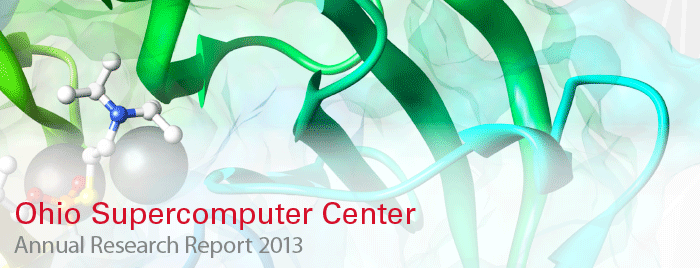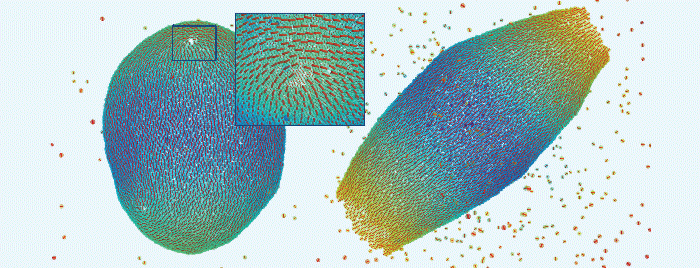These simulations depict two vesicles in equilibrium with surfactant molecules in solution. On the left, the vesicle has four defects with topological charge of +1/2 each; the inset shows an expanded view of one of these defects. On the right, the defects have merged into holes at the ends of the vesicles.
Liquid crystals are at the heart of the technology inside most computer, tablet and smartphone displays today, and researchers are finding more applications for liquid crystals every day – in fields, such as advanced photonics, sensors, bio- and medical molecular devices, and smart materials for new energy applications.
Liquid crystals are chemical compounds that can behave like both conventional liquids and solid crystals. They can demonstrate vastly different properties, depending upon the position and orientation of its molecules in arrangements that researchers describe as phases. One of the most common is the nematic phase, where molecules align themselves parallel to each other but not in well-defined planes within tiny hollow spheres called vesicles. The long-axis orientation of a nematic molecule is referred to as its director.
“In membranes with nematic liquid-crystalline order, there is a geometric coupling between the nematic director and the shape: nonuniformity in the director induces curvature, and curvature provides an effective potential acting on the director,” said Jonathan Selinger, Ph.D., an Ohio Eminent Scholar at the Liquid Crystal Institute and a professor of chemical physics at Kent State University.
For a closed vesicle, there must be a total topological charge of +2, which normally occurs as four defects of charge +1/2 each. Previous research has suggested that these four defects will form a regular tetrahedron – a shape with four triangular faces – which leads to a tetrahedral-shaped vesicle, a feature that may be useful in designing very small, colloidal particles for photonic applications.
Selinger’s group, also guided by Robin Selinger, Ph.D., a professor of chemical physics at KSU, took three approaches to investigating the behavior of a nematic vesicle: particle-based simulation, spherical harmonic expansion and finite-element modeling. When a liquid crystal has a purely 2-D intrinsic interaction, they found that the perfect tetrahedral shape is stable over a wide range of parameters. However, they also found that when it has a 3-D intrinsic and extrinsic interaction, the perfect tetrahedral shape is never stable, demonstrating the difficulty in designing tetrahedral structures for photonic crystals.
These studies of non-ideal behavior in nematic membranes led to the motivation for additional research: to understand what other types of non-ideality are important for orientational order on curved or deformable surfaces. In particular, when will researchers see the tetrahedral arrangement of defects that is useful for photonic crystals, and when will other structures occur?
Project Lead: Jonathan V. Selinger, Kent State University
Research Title: Nematic order on a deformable vesicle: theory and simulation
Funding Source: National Science Foundation

